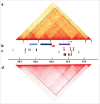SOX9 chromatin folding domains correlate with its real and putative distant cis-regulatory elements
- PMID: 28085555
- PMCID: PMC5403132
- DOI: 10.1080/19491034.2017.1279776
SOX9 chromatin folding domains correlate with its real and putative distant cis-regulatory elements
Abstract
Evolutionary conserved transcription factor SOX9, encoded by the dosage sensitive SOX9 gene on chromosome 17q24.3, plays an important role in development of multiple organs, including bones and testes. Heterozygous point mutations and genomic copy-number variant (CNV) deletions involving SOX9 have been reported in patients with campomelic dysplasia (CD), a skeletal malformation syndrome often associated with male-to-female sex reversal. Balanced and unbalanced structural genomic variants with breakpoints mapping up to 1.3 Mb up- and downstream to SOX9 have been described in patients with milder phenotypes, including acampomelic campomelic dysplasia, sex reversal, and Pierre Robin sequence. Based on the localization of breakpoints of genomic rearrangements causing different phenotypes, 5 genomic intervals mapping upstream to SOX9 have been defined. We have analyzed the publically available database of high-throughput chromosome conformation capture (Hi-C) in multiple cell lines in the genomic regions flanking SOX9. Consistent with the literature data, chromatin domain boundaries in the SOX9 locus exhibit conservation across species and remain largely constant across multiple cell types. Interestingly, we have found that chromatin folding domains in the SOX9 locus associate with the genomic intervals harboring real and putative regulatory elements of SOX9, implicating that variation in intra-domain interactions may be critical for dynamic regulation of SOX9 expression in a cell type-specific fashion. We propose that tissue-specific enhancers for other transcription factor genes may similarly utilize chromatin folding sub-domains in gene regulation.
Keywords: chromatin looping; long distance gene regulation; non-coding variants; structural variants; tissue-specific enhancers.
Figures


Similar articles
-
Chromosome conformation capture-on-chip analysis of long-range cis-interactions of the SOX9 promoter.Chromosome Res. 2013 Dec;21(8):781-8. doi: 10.1007/s10577-013-9386-4. Epub 2013 Nov 20. Chromosome Res. 2013. PMID: 24254229
-
A de novo 1.58 Mb deletion, including MAP2K6 and mapping 1.28 Mb upstream to SOX9, identified in a patient with Pierre Robin sequence and osteopenia with multiple fractures.Am J Med Genet A. 2015 Aug;167A(8):1842-50. doi: 10.1002/ajmg.a.37057. Epub 2015 Jun 8. Am J Med Genet A. 2015. PMID: 26059046
-
Identification of novel craniofacial regulatory domains located far upstream of SOX9 and disrupted in Pierre Robin sequence.Hum Mutat. 2014 Aug;35(8):1011-20. doi: 10.1002/humu.22606. Hum Mutat. 2014. PMID: 24934569 Free PMC article.
-
Long-range regulation at the SOX9 locus in development and disease.J Med Genet. 2009 Oct;46(10):649-56. doi: 10.1136/jmg.2009.068361. Epub 2009 May 26. J Med Genet. 2009. PMID: 19473998 Review.
-
SOX9: A genomic view of tissue specific expression and action.Int J Biochem Cell Biol. 2017 Jun;87:18-22. doi: 10.1016/j.biocel.2017.03.005. Epub 2017 Mar 16. Int J Biochem Cell Biol. 2017. PMID: 28323209 Review.
Cited by
-
Genomic technologies and the diagnosis of 46, XY differences of sex development.Andrology. 2025 Jul;13(5):1025-1043. doi: 10.1111/andr.13708. Epub 2024 Jul 31. Andrology. 2025. PMID: 39081229 Free PMC article. Review.
-
Integration of 3D genome topology and local chromatin features uncovers enhancers underlying craniofacial-specific cartilage defects.Sci Adv. 2022 Nov 25;8(47):eabo3648. doi: 10.1126/sciadv.abo3648. Epub 2022 Nov 23. Sci Adv. 2022. PMID: 36417512 Free PMC article.
-
SOX9 in organogenesis: shared and unique transcriptional functions.Cell Mol Life Sci. 2022 Sep 17;79(10):522. doi: 10.1007/s00018-022-04543-4. Cell Mol Life Sci. 2022. PMID: 36114905 Free PMC article. Review.
-
Genome-wide assessment of gene-by-smoking interactions in COPD.Sci Rep. 2018 Jun 18;8(1):9319. doi: 10.1038/s41598-018-27463-5. Sci Rep. 2018. PMID: 29915320 Free PMC article.
-
Diverse Regulation but Conserved Function: SOX9 in Vertebrate Sex Determination.Genes (Basel). 2021 Mar 26;12(4):486. doi: 10.3390/genes12040486. Genes (Basel). 2021. PMID: 33810596 Free PMC article. Review.
References
-
- Gordon CT, Tan TY, Benko S, FitzPatrick D, Lyonnet S, Farlie PG. Long-range regulation at the SOX9 locus in development and disease. J Med Genet 2009; 46:649-56; PMID:19473998; http://dx.doi.org/10.1136/jmg.2009.068361 - DOI - PubMed
-
- Foster JW, Dominguez-Steglich MA, Guioli S, Kwok C, Weller PA, Stevanović M, Weissenbach J, Mansour S, Young ID, Goodfellow PN, et al.. Campomelic dysplasia and autosomal sex reversal caused by mutations in an SRY-related gene. Nature 1994; 372:525-30; PMID:7990924; http://dx.doi.org/10.1038/372525a0 - DOI - PubMed
-
- Wagner T, Wirth J, Meyer J, Zabel B, Held M, Zimmer J, Pasantes J, Bricarelli FD, Keutel J, Hustert E, et al.. Autosomal sex reversal and campomelic dysplasia are caused by mutations in and around the SRY-related gene SOX9. Cell 1994; 79:1111-20; PMID:8001137; http://dx.doi.org/10.1016/0092-8674(94)90041-8 - DOI - PubMed
-
- Mansour S, Hall CM, Pembrey ME, Young ID. A clinical and genetic study of campomelic dysplasia. J Med Genet 1995; 32:415-20; PMID:7666392; http://jmg.bmj.com.ezproxyhost.library.tmc.edu/content/32/6/415.long - PMC - PubMed
-
- Wirth J, Wagner T, Meyer J, Pfeiffer RA, Tietze HU, Schempp W, Scherer G. Translocation breakpoints in three patients with campomelic dysplasia and autosomal sex reversal map more than 130 kb from SOX9. Hum Genet 1996; 97:186-93; PMID:8566951; http://link.springer.com.ezproxyhost.library.tmc.edu/article/10.1007/BF0... - DOI - PubMed
MeSH terms
Substances
LinkOut - more resources
Full Text Sources
Other Literature Sources
Research Materials
Miscellaneous
